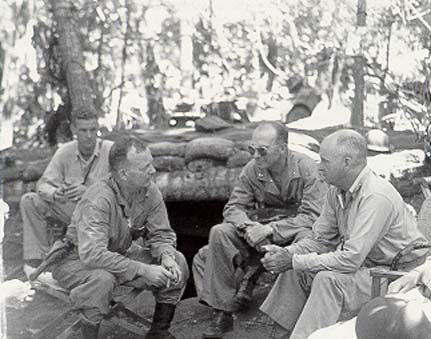
U.S. Army Major General Alexander Patch (center) succeeds Vandegrift (right) on 9 December 1942.
The lack of a harbor compounded U.S. supply problems, as did Japanese aircraft attacks. Allied “coast watchers” on islands provided early warning to U.S. forces of Japanese air and water movements down the so-called Slot of the Solomons. The battle on Guadalcanal became a complex campaign of attrition. The Japanese did not send their main fleet but rather vessels in driblets. American land-based air power controlled the Slot during the day, but the Japanese initially controlled it at night, as was evidenced in the 8 August Battle of Savo Island. Concern over the vulnerability of the U.S. transports led to their early removal on the afternoon of 9 August along with most of the heavy guns, vehicles, construction equipment, and food intended for the Marines ashore. The Japanese sent aircraft from Rabaul, while initially U.S. land-based aircraft flying at long range from the New Hebrides provided air cover for the Marines as fast destroyer transports finally brought in some supplies. American possession of Henderson Field tipped the balance. U.S. air strength there gradually increased to about 100 planes.
At night the so-called Tokyo Express—Japanese destroyers and light cruisers—steamed down the Slot and into the sound to shell Marine positions and to deliver supplies. The latter effort was haphazard and never sufficient; often, drums filled with supplies were pushed off the ships to drift to shore. One of the great what-ifs of the Pacific War was the failure of the Japanese to exploit the temporary departure of the U.S. carrier task force on 8 August by rushing in substantial reinforcements.
Actions ashore were marked by clashes between patrols of both sides. Colonel Ichiki Kiyonao, who had arrived with his battalion on Guadalacanal in early August, planned a large-scale attack that took little account of U.S. Marine dispositions. His unit was effectively wiped out in the 21 August 1942 Battle of the Tenaru River. Ichiki’s men refused to surrender, and they and their commander were killed in the fighting. Marine losses were 44 dead and 71 wounded; the Japanese lost at least 777 killed. From 12 to 14 September, strong Japanese forces attempted to seize U.S. Marine positions on Lunga Ridge overlooking Henderson Field from the south. The Japanese left 600 dead; American casualties were 143 dead and wounded. Both sides continued building up their strength ashore as naval and air battles raged over and off Guadalcanal.
From 23 to 25 October, the Japanese launched strong land attacks against Henderson Field. Fortunately for the Marine defenders, the attacks were widely dispersed and uncoordinated. In these engagements, the Japanese suffered 2,000 dead, while U.S. casualties were fewer than 300. Immediately after halting this Japanese offensive, Vandegrift began a six week effort to expand the defensive perimeter beyond which the Japanese could not subject Henderson to artillery fire. Meanwhile, Admiral Kondo Nobutake’s repositioning of vessels and Vice Admiral William F. Halsey’s instructions to Rear Admiral Thomas Kinkaid to seek out the Japanese fleet resulted in the 26 October Battle of the Santa Cruz Islands.
Fighting on land continued on Guadalcanal. On 8 December, Vandegrift turned command of the island over to U.S. Army Major General Alexander M. Patch, who organized his forces into the XIV Corps, including the 2nd Marine Division, replacing the veteran 1st Marine Division, which was withdrawn, and the 25th Infantry Division. At the beginning of January 1943, Patch commanded 58,000 men, whereas Japanese strength was then less than 20,000.
Ultimately, the Americans won the land struggle for Guadalcanal thanks to superior supply capabilities and the failure of the Japanese to throw sufficient resources into the battle. The Americans were now well fed and well supplied, but the Japanese were desperate, losing many men to sickness and simple starvation. At the end of December, Tokyo decided to abandon Guadalcanal.
Meanwhile, on 10 January, Patch began an offensive to clear the island of Japanese forces, mixing Army and Marine units as the situation dictated. In a two-week battle, the Americans drove the Japanese from a heavily fortified line west of Henderson Field. At the end of January, the Japanese were forced from Tassafaronga toward Cape Esperance, where a small American force landed to prevent them from escaping by sea. Dogged Japanese perseverance and naval support, however, enabled some defenders to escape. The Japanese invested in the struggle 24,600 men (20,800 troops and 3,800 naval personnel). In daring night operations during 1–7 February 1943, Japanese destroyers evacuated 10,630 troops (9,800 army and 830 navy).
The United States committed 60,000 men to the fight for the island; of these, the Marines lost 1,207 dead and the army 562. U.S. casualties were far greater in the naval contests for Guadalcanal; the U.S. Navy and Marines lost 4,911 and the Japanese at least 3,200. Counting land, sea, and air casualties, the struggle for Guadalcanal had claimed 7,100 U.S. dead and permanently missing. The Japanese advance had now been halted, and MacArthur could begin the long and bloody return to the Philippine Islands.
References Bergerud, Eric. Touched with Fire: The Land War in the South Pacific. New York: Viking, 1996. Frank, Richard B. Guadalcanal: The Definitive Account of the Landmark Battle. New York: Random House, 1990. Hough, Frank O., Verle E. Ludwig, and Henry I. Shaw. History of Marine Corps Operation in World War II: Pearl Harbor to Guadalcanal. Washington, DC: Government Printing Office, 1963. Miller, John, Jr. United States Army in World War II: The War in the Pacific: Guadalcanal, the First Offensive. Washington, DC: Government Printing Office, 1949. Mueller, Joseph N. Guadalcanal 1942: The Marines Strike Back. London: Osprey, 1992. Tregaskis, Richard. Guadalcanal Diary. New York: Random House, 1943.